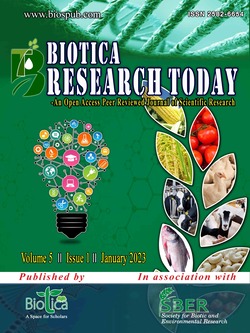
Green Approaches for Freshwater Eutrophication Management
Jesna P.K.
Regional Centre of ICAR-Central Inland Fisheries Research Institute, Bangalore, Karnataka (560 089), India
Ajoy Saha*
ICAR-Central Inland Fisheries Research Institute, Barrackpore, Kolkata, West Bengal (700 120), India
B.K. Das
ICAR-Central Inland Fisheries Research Institute, Barrackpore, Kolkata, West Bengal (700 120), India
DOI: NIL
Keywords: Eutrophication management, Green technologies, Phyto-remediation, Water quality
Abstract
Phosphorus (P) plays an important role in the inland aquatic ecosystems. However, inland aquatic ecosystems like, wetlands, reservoirs, and rivers are gradually accumulating this element and as a consequence eutrophication becomes a global problem. Eutrophication causes excessive algal growth, disrupting the composition and distribution of aquatic flora and fauna, disturbing the aquatic food web and also degrading the recreational area. Therefore, the management of eutrophication is necessary for the restoration of freshwater aquatic bodies. Conventional treatments like chemical treatments lead to the addition of external chemicals to the ecosystem. Hence, technologies, for rapidly reducing phosphorus content or influx and reduction in organic matter are necessary to overcome the problem of eutrophication in long term. Green techniques are also referred to as an environmentally friendly solution to this problem. Various green techniques like phytoremediation, microbial remediation, and the use of agricultural waste as green adsorbent for remediation may be the alternative options for P mitigation in freshwater ecosystems.
Downloads
not found
Reference
Chislock, M.F., Doster, E., Zitomer, R.A., Wilson, A.E., 2013. Eutrophication: Causes, Consequences, and Controls in Aquatic Ecosystems. Nature Education Knowledge 4(4), 10.
El-Sheekh, M., Abdel-Daim, M.M., Okba, M., Gharib, S., Soliman, A., El-Kassas, H., 2021. Green technology for bioremediation of the eutrophication phenomenon in aquatic ecosystems: a review. African Journal of Aquatic Science 46(3), 274-292.
Paul, B., Purkayastha, K.D., Bhattacharya, S., Gogoi, N., 2022. Eco-bioengineering Tools in Ecohydrological Assessment of Eutrophic Water Bodies. Ecotoxicology 31(4), 581-601.
Wang, T., Lin, J., Chen, Z., Megharaj, M., Naidu, R., 2014. Green Synthesized Iron Nanoparticles by Green Tea and Eucalyptus Leaves Extracts Used for Removal of Nitrate in Aqueous Solution. Journal of Cleaner Production 83, 413-419.
